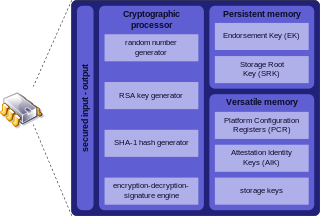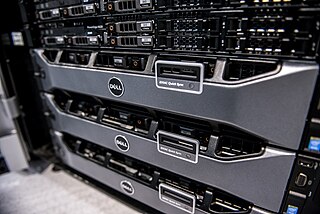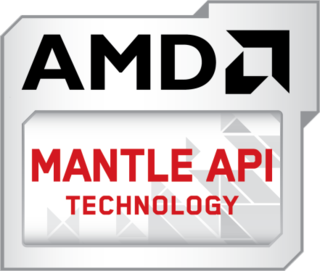
Advanced Micro Devices, Inc. (AMD) is an American multinational semiconductor company based in Santa Clara, California, that develops computer processors and related technologies for business and consumer markets.
In computing, floating point operations per second is a measure of computer performance, useful in fields of scientific computations that require floating-point calculations. For such cases, it is a more accurate measure than measuring instructions per second.

In computer hardware, a CPU socket or CPU slot contains one or more mechanical components providing mechanical and electrical connections between a microprocessor and a printed circuit board (PCB). This allows for placing and replacing the central processing unit (CPU) without soldering.
The Berkeley r-commands are a suite of computer programs designed to enable users of one Unix system to log in or issue commands to another Unix computer via TCP/IP computer network. The r-commands were developed in 1982 by the Computer Systems Research Group at the University of California, Berkeley, based on an early implementation of TCP/IP.

Trusted Platform Module (TPM) is an international standard for a secure cryptoprocessor, a dedicated microcontroller designed to secure hardware through integrated cryptographic keys. The term can also refer to a chip conforming to the standard ISO/IEC 11889.

The PowerEdge (PE) line is Dell's server computer product line. PowerEdge machines come configured as tower, rack-mounted, or blade servers. Dell uses a consistent chip-set across servers in the same generation regardless of packaging, allowing for a common set of drivers and system-images.
In the x86 architecture, the CPUID instruction is a processor supplementary instruction allowing software to discover details of the processor. It was introduced by Intel in 1993 with the launch of the Pentium and SL-enhanced 486 processors.

The Cobalt Qube was a computer server appliance product line, meant to be web servers, developed by Cobalt Networks, Inc. from 1998 to 2002 featuring a modified Red Hat Linux operating system and a proprietary GUI for server management. The original Qube systems were equipped with RM5230 or RM5231 microprocessors but later models used AMD K6-2 chips. NetBSD operating system has been ported to both the Cobalt Qube and RaQ.

Oracle VM VirtualBox is a type-2 hypervisor for x86 virtualization developed by Oracle Corporation. VirtualBox was originally created by InnoTek Systemberatung GmbH, which was acquired by Sun Microsystems in 2008, which was in turn acquired by Oracle in 2010.

Microsoft Hyper-V, codenamed Viridian, and briefly known before its release as Windows Server Virtualization, is a native hypervisor; it can create virtual machines on x86-64 systems running Windows. Starting with Windows 8, Hyper-V superseded Windows Virtual PC as the hardware virtualization component of the client editions of Windows NT. A server computer running Hyper-V can be configured to expose individual virtual machines to one or more networks. Hyper-V was first released with Windows Server 2008, and has been available without additional charge since Windows Server 2012 and Windows 8. A standalone Windows Hyper-V Server is free, but has a command-line interface only. The last version of free Hyper-V Server is Hyper-V Server 2019, which is based on Windows Server 2019.
AMD FireStream was AMD's brand name for their Radeon-based product line targeting stream processing and/or GPGPU in supercomputers. Originally developed by ATI Technologies around the Radeon X1900 XTX in 2006, the product line was previously branded as both ATI FireSTREAM and AMD Stream Processor. The AMD FireStream can also be used as a floating-point co-processor for offloading CPU calculations, which is part of the Torrenza initiative. The FireStream line has been discontinued since 2012, when GPGPU workloads were entirely folded into the AMD FirePro line.

The Droid X is a smartphone released by Motorola on July 2010. The smartphone was renamed Motoroi X for its release in Mexico on November 9, 2013. The Droid X runs on the Android operating system, and the latest version supported was 2.3 Gingerbread. It was distributed by Verizon Wireless in the United States and Iusacell in Mexico.
Intel Quick Sync Video is Intel's brand for its dedicated video encoding and decoding hardware core. Quick Sync was introduced with the Sandy Bridge CPU microarchitecture on 9 January 2011 and has been found on the die of Intel CPUs ever since.
AMD Piledriver Family 15h is a microarchitecture developed by AMD as the second-generation successor to Bulldozer. It targets desktop, mobile and server markets. It is used for the AMD Accelerated Processing Unit, AMD FX, and the Opteron line of processors.
AMD Steamroller Family 15h is a microarchitecture developed by AMD for AMD APUs, which succeeded Piledriver in the beginning of 2014 as the third-generation Bulldozer-based microarchitecture. Steamroller APUs continue to use two-core modules as their predecessors, while aiming at achieving greater levels of parallelism.

Mantle was a low-overhead rendering API targeted at 3D video games. AMD originally developed Mantle in cooperation with DICE, starting in 2013. Mantle was designed as an alternative to Direct3D and OpenGL, primarily for use on personal computers, although Mantle supports the GPUs present in the PlayStation 4 and in the Xbox One. In 2015, Mantle's public development was suspended and in 2019 completely discontinued, as DirectX 12 and the Mantle-derived Vulkan rose in popularity.

Gigas is an international cloud computing services company based in Madrid, Spain. The company began as a start-up in 2011. The company has data centers in Madrid and Miami, and offices in Spain, US, Colombia, Chile, Peru and Panama.

A microDataCenter contains compute, storage, power, cooling and networking in a very small volume, sometimes also called a "DataCenter-in-a-box". The term has been used to describe various incarnations of this idea over the past 20 years. Late 2017 a very tightly integrated version was shown at SuperComputing conference 2017: the DOME microDataCenter. Key features are its hot-watercooling, fully solid-state and being built with commodity components and standards only.

Ampere Computing LLC is an American fabless semiconductor company based in Santa Clara, California that develops processes for servers operating in large scale environments. Ampere also has offices in: Portland, Oregon; Taipei, Taiwan; Raleigh, North Carolina; Bangalore, India; Warsaw, Poland; and Ho Chi Minh City, Vietnam.











